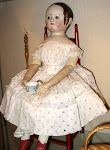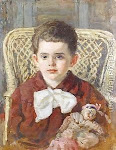
"Princess Elizabeth of York" Currently Queen Elizabeth II of England ca. 1933
The Royal Family ca. 1935
*********************************
At the height of World War I, German xenophobia had reached boiling point.
From 1914 to 1918 Britain was at war with Germany. The German Kaiser Wilhelm II, who for the British public came to symbolize all the horrors of the war, was the King's first cousin…At this time H.G.Wells commented about Britain's "alien and uninspiring court".


Edward VII's son, King George V (1910- 1936) famously replied: "I may be uninspiring, but I'll be damned if I'm alien." George appeased British nationalist feelings by changing the name of the British Royal House from the German-sounding House of Saxe-Coburg and Gotha to the House of Windsor.

George was born on 3 June 1865. His father was the eldest son of Queen Victoria and
Prince Albert of Saxe-Coburg and Gotha. His mother was the eldest daughter of King Christian IX of Denmark.. He was third in line to the throne, after his father and elder brother,Prince Albert Victor.

In November 1891, George's elder brother Albert Victor became engaged to, Princess Victoria Mary of Teck, known as "May". Six weeks after the formal engagement, Albert Victor died of pneumonia, leaving George second in line to the throne. Queen Victoria still regarded Princess May as a suitable match for her grandson. A year after Albert Victor's death, George duly proposed to May and was accepted. They married on 6 July 1893 at the Chapel Royal, in St. James’s Palace, London.

On 6 May 1910, King Edward VII died, and George became King. George insisted his wife should drop the name “Victoria”. Neither thought she should be called Queen Victoria, and so she became Queen Mary.

King George and Queen Mary by Crooke
***************************
He was concerned by the coming to power in 1933 of Hitler and the Nazis in Germany. In 1934 the king bluntly told the German ambassador that Germany was now the peril of the world, and that, if she went on at the present rate, there was bound to be a war within ten years; he warned his ambassador in Berlin to be suspicious of the Nazis.

"Queen Elizabeth II" ca. 1929
********************************
King George was very fond of his second eldest son, Prince Albert (later George VI) and doted on his eldest granddaughter, Princess Elizabeth ; he nicknamed her "Lilibet", and she affectionately called him "Grandpa England". George said of his son Edward: "After I am dead, the boy will ruin himself within 12 months ", and of Albert and Lilibet: "I pray to God my eldest son, Edward, will never marry and have children, and that nothing will come between Bertie and Lilibet and the throne."
*****************************************
A look at some of the events that shaped the world during George V reign
***********************
1910
Boy Scouts of America founded.
King George V, second son of Edward VII, begins a 25-year reign as monarch of Britain

King George Coronation Souvenir

The Boy Scouts of America (BSA) was inspired by and modeled on the Boy Scout Association, established by Baden-Powell in Britain in 1908. In the early 1900s, several youth organizations were active, and many became part of the BSA.
The BSA grew rapidly and became the largest youth organization in the United States for younger boys, the Cubbing program arose and for older boys, Rovering and Exploring programs were developed. Additional programs and changes have occurred over the years to adapt the program to the youth of the day.
1912
White Star line steamer Titanic sinks on maiden voyage after hitting an iceberg in the North Atlantic on April 14. 1503 people drown.
 RMS Titanic
RMS Titanic owned by the White Star Line was the largest passenger steamship in the world. She set off on her maiden voyage from Southampton, England to New York City on 10 April 1912 with 2,227 people on board. Four days into the crossing, at 23:40 on 14 April 1912, she struck an iceberg and sank at 2:20 the following morning, resulting in the deaths of 1,517 people in one of the deadliest peacetime maritime disaster in history.

The high casualty rate when the ship sank was due in part to the fact that, although complying with the regulations of the time, the ship carried lifeboats for only 1,178 people. A disproportionate number of men died due to the women and children first protocol that was followed.
1915
The first transcontinental phone call is made from New York to San Francisco by Alexander Graham Bell and Thomas A. Watson.
The British ship Lusitania is torpedoed by a German submarine. 128 of those lost at sea were Americans.
 On January 25, 1915, the words “Hello, Jekyll Island,” reverberated across the phone lines, as Vail joined a party phone call with President Woodrow Wilson in Washington, DC, Alexander Graham Bell in New York, and Thomas Watson in San Francisco. This thrilling moment marked the ceremonial grand opening of the first transcontinental telephone service.
On January 25, 1915, the words “Hello, Jekyll Island,” reverberated across the phone lines, as Vail joined a party phone call with President Woodrow Wilson in Washington, DC, Alexander Graham Bell in New York, and Thomas Watson in San Francisco. This thrilling moment marked the ceremonial grand opening of the first transcontinental telephone service.
 RMS Lusitania coming into port, possibly in New York 1907-1913
RMS Lusitania coming into port, possibly in New York 1907-1913
*************************************
RMS Lusitania was an ocean liner owned by the Cunard Line and built by John Brown and Company of Clydebank, Scotland. She was torpedoed by German U-boat U-20 on 7 May 1915 and sank in eighteen minutes, eleven miles (19 km) off the Old Head of Kinsale , Ireland, killing 1,198 of the 1,959 people aboard.

The sinking turned public opinion in many countries against Germany and contributed to the entry of the United States into World War I The sinking of Lusitania was a coup for anti-German sentiment, caused great controversy and became an iconic symbol in recruiting campaigns of why the war was being fought.
1918
More than one million troops are in Europe by the middle of the year. The Great War ends with the signing of the Armistice on November 11

"Armistice Day" ca. 1918
**************************************
Armistice Day (also known as Remembrance Day) is on November 11 and commemorates the armistice signed between the Allies of World War I and Germany at Compiegne, France, for the cessation of hostilities on theWestern Front, which took effect at eleven o'clock in the morning—the "eleventh hour of the eleventh day of the eleventh month" of 1918.
1920
Nineteenth Amendment gives U.S. women the right to vote. Prohibition of alcohol takes effect in the United States.
The 19th amendment guarantees all American women the right to vote. Beginning in the mid-19th century, several generations of woman suffrage supporters lectured, wrote, marched, lobbied, and practiced civil disobedience to achieve what many Americans considered a radical change of the Constitution. Few early supporters lived to see final victory in 1920.

Prohibition was the period in United States history in which the manufacture, sale, and transportation of intoxicating liquors was outlawed. It was a time characterized by speakeasies, glamour, and gangsters and a period of time in which even the average citizen broke the law. Almost immediately after the ratification of the 18th Amendment, organizations formed to repeal it. As the perfect world promised by the Temperance movement failed to materialize, more people joined the fight to bring back liquor.
On December 5, 1933, the 21st Amendment to the U.S. Constitution was ratified. The 21st Amendment repealed the 18th Amendment, making alcohol once again legal. This was the first and only time in U.S. history that an Amendment has been repealed.

As unpopular as prohibition was, it took 12 more years of speakeasy raids and booze being dumped into sewers for it to be repealed. Here, a crime against beer in lower Manhattan:
1925
F. Scott Fitzgerald's The Great Gatsby published. The Charleston is the dance of the Jazz Age.
"Model T"
********************************
The "Roaring Twenties", and the "Jazz Age" was a time of release after the horrors of the First World War, a boom-time of prosperity and pleasure. But how real was that prosperity for most Americans? And why, in 1929, did the good times Crash?


Charleston Dance Becomes Popular (1923): The Charleston dance became popular after appearing along with the song, "The Charleston," by James P. Johnson in the Broadway musical Runnin' Wild in 1923.
Although the origins of the dance are obscure, the dance has been traced back to blacks who lived on an island off the coast of Charleston, South Carolina (which is why the dance is called "Charleston"). The music for the Charleston is ragtime jazz, in quick 4/4 time with syncopated rhythms.
Original Charleston, 1923 , The legendary Josephine Baker on a French music sheet cover for the Twenties dance craze.
1927
Charles Lindbergh makes first trans-Atlantic crossing.

Charles Lindbergh made the first solo airplane flight across the Atlantic Ocean. He left Roosevelt Field in New York on 20 May 1927, piloting a plane named The Spirit of St. Louis. 33 1/2 hours later he landed in Paris to a hero's welcome and permanent international fame. During 1939 and 1940 Lindbergh was a vocal opponent of American entry into World War II. However, after the Japanese attack at Pearl Harbor he joined the war effort, eventually flying 50 combat missions in the Pacific.
1931
Depression sweeps worldwide

The Great Depression was a severe worldwide economic depression in the decade preceding World War II. The timing of the Great Depression varied across nations, but in most countries it started in about 1929 and lasted until the late 1930s or early 1940s. It was the longest, most widespread, and deepest depression of the 20th century. In the 21st century, the Great Depression is commonly used as an example of how far the world's economy can decline. The depression originated in the U.S., starting with the fall in stock prices that began around September 4, 1929 and became worldwide news with the stock market crash of October 29, 1929 (known as Black Tuesday). From there, it quickly spread to almost every country in the world.
1933
Hitler becomes chancellor of Germany. Boycott of Jews begins in Germany.

On the night of January 30, 1933, Adolph Hitler was appointed Chancellor of Germany .
Within weeks, he would be absolute dictator of Germany and would set in motion a chain of events resulting in the Second World War. Hitler would see the German democratic republic go down in flames, once and for all.
"Yellow Star"
***********************
The Nazis are widely considered to have been one of the most evil and vicious political organizations ever to have existed.
These masters of destruction and organized insanity were responsible for the eventual deaths of nearly 50 million humans through the war, and including around six million Jews in the Holocaust by deliberate extermination. .
Emanuel and Avram Rosenthal, who died at Majdanek. Two little boys who were forced to wear the Yellow Identification Star of David all Jews were forced to wear at all times.
1936
King George V of England dies, and is succeeded by his son, Edward VIII, who abdicates for "the woman I love" and is succeeded by his brother, George VI

Edward and Wallis
******************************
King Edward VIII did something that monarchs do not have the luxury of doing - he fell in love. King Edward was in love with Mrs. Wallis Simpson, not only an American, but also a married woman already once divorced. Yet, in order to marry the woman he loved, King Edward was willing to give up the British throne - and he did.
1937
Radio broadcast of King George VI's coronation is the first worldwide program heard in the U.S

British Royal Family
*********************************
On May 12, 1937, George VI was crowned King of England, succeeding his brother Edward who abdicated to marry American divorcee Wallis Warfield Simpson. He is shown here with his wife Queen Elizabeth and daughters Margaret (L) and Elizabeth.
 "Princess Elizabeth of York" Currently Queen Elizabeth II of England ca. 1933
"Princess Elizabeth of York" Currently Queen Elizabeth II of England ca. 1933




 King George and Queen Mary by Crooke
King George and Queen Mary by Crooke "Queen Elizabeth II" ca. 1929
"Queen Elizabeth II" ca. 1929

 RMS Titanic owned by the White Star Line was the largest passenger steamship in the world. She set off on her maiden voyage from Southampton, England to New York City on 10 April 1912 with 2,227 people on board. Four days into the crossing, at 23:40 on 14 April 1912, she struck an iceberg and sank at 2:20 the following morning, resulting in the deaths of 1,517 people in one of the deadliest peacetime maritime disaster in history.
RMS Titanic owned by the White Star Line was the largest passenger steamship in the world. She set off on her maiden voyage from Southampton, England to New York City on 10 April 1912 with 2,227 people on board. Four days into the crossing, at 23:40 on 14 April 1912, she struck an iceberg and sank at 2:20 the following morning, resulting in the deaths of 1,517 people in one of the deadliest peacetime maritime disaster in history. 
 On January 25, 1915, the words “Hello, Jekyll Island,” reverberated across the phone lines, as Vail joined a party phone call with President Woodrow Wilson in Washington, DC, Alexander Graham Bell in New York, and Thomas Watson in San Francisco. This thrilling moment marked the ceremonial grand opening of the first transcontinental telephone service.
On January 25, 1915, the words “Hello, Jekyll Island,” reverberated across the phone lines, as Vail joined a party phone call with President Woodrow Wilson in Washington, DC, Alexander Graham Bell in New York, and Thomas Watson in San Francisco. This thrilling moment marked the ceremonial grand opening of the first transcontinental telephone service. RMS Lusitania coming into port, possibly in New York 1907-1913
RMS Lusitania coming into port, possibly in New York 1907-1913
 "Armistice Day" ca. 1918
"Armistice Day" ca. 1918





 On the night of January 30, 1933, Adolph Hitler was appointed Chancellor of Germany .
On the night of January 30, 1933, Adolph Hitler was appointed Chancellor of Germany . Edward and Wallis
Edward and Wallis












































.jpg)






































































































